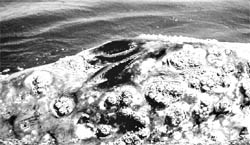Bioinspectors
 in the early 1980s, an illegal battery-disposal operation in Hong Kong's Junk Bay was releasing large amounts of polychlorinated biphenyls, lead and zinc into the water. But the crime did not escape everyone's vigil. The barnacles and mussels in the bay concentrated the pollutants in their tissues. The evidence they provided helped the authorities shutdown the law-breakers. This was the first time biomarkers were used to pin down polluters.
in the early 1980s, an illegal battery-disposal operation in Hong Kong's Junk Bay was releasing large amounts of polychlorinated biphenyls, lead and zinc into the water. But the crime did not escape everyone's vigil. The barnacles and mussels in the bay concentrated the pollutants in their tissues. The evidence they provided helped the authorities shutdown the law-breakers. This was the first time biomarkers were used to pin down polluters.
Enthusiasts for biomonitoring argue that their field is now coming of age. In many cases, researchers are now combining ecological studies with analytical chemistry to produce information on the effects of pollution on living organisms, the identity of the chemicals involved and even where they came from. Biomonitoring has long been the poor relation to the straightforward chemical analysis of water, air and soil. Chemical sensors can provide highly accurate readings of environmental pollution. But in some regards, say experts, this precision is spurious. Instruments can quantify the amount of a pollutant present in the environment. But if organisms do not take up a pollutant, it may cause little damage to an ecosystem. And the extent to which it is taken up by the organisms may depend on a range of factors, including climate and acidity.
Community values In the uk the presence of some invertebrate species is used to monitor 7,000 river sites across the country. Although assessments based on community ecology are good at exposing severe pollution events, they are less useful at providing subtle warning signs that an ecosystem is coming under pressure. They can only tell you that you've had a major impact after the event has occurred. But combining ecological observations with chemical measurement of pollutants accumulated by animals and plants can provide a much more sensitive and predictive analysis. Marine scientists have led the way in this. In 1998, the European Union set up a project called Biological Effects Quality Assurance in Marine Monitoring to standardise marine biological monitoring. By the time this project ends in October 2001, a network of laboratories in the uk , Norway, Sweden and Germany will have worked out about half a dozen standardised measures, including the activity levels in fish of enzymes that process trace metals and organic pollutants, pathological analysis of fish livers and community analysis of planktonic plants and invertebrates living in the seabed. The best methods of detection are emerging
